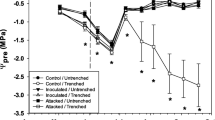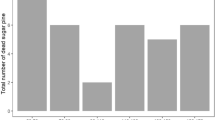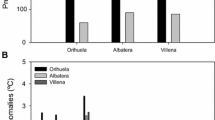Abstract
The relative importance of growth and defense to tree mortality during drought and bark beetle attacks is poorly understood. We addressed this issue by comparing growth and defense characteristics between 25 pairs of ponderosa pine (Pinus ponderosa) trees that survived and trees that died from drought-associated bark beetle attacks in forests of northern Arizona, USA. The three major findings of our research were: (1) xylem resin ducts in live trees were >10% larger (diameter), >25% denser (no. of resin ducts mm−2), and composed >50% more area per unit ring growth than dead trees; (2) measures of defense, such as resin duct production (no. of resin ducts year−1) and the proportion of xylem ring area to resin ducts, not growth, were the best model parameters of ponderosa pine mortality; and (3) most correlations between annual variation in growth and resin duct characteristics were positive suggesting that conditions conducive to growth also increase resin duct production. Our results suggest that trees that survive drought and subsequent bark beetle attacks invest more carbon in resin defense than trees that die, and that carbon allocation to resin ducts is a more important determinant of tree mortality than allocation to radial growth.


Similar content being viewed by others
References
Baier P, Führer E, Kirisits T, Rosner S (2002) Defence reactions of Norway spruce against bark beetles and the associated fungus Ceratocystis polonica in secondary pure and mixed species stands. For Ecol Manage 159:73–86
Bigler C, Bugmann H (2003) Growth-dependent tree mortality models based on tree rings. Can J For Res 33:210–221
Bigler C, Gricar J, Bugmann H, Cufar K (2004) Growth patterns as indicators of impending tree death in silver fir. For Ecol Manage 199:183–190
Blanche CA, Lorio PL, Sommers RA, Hodges JD, Nebeker TE (1992) Seasonal cambial growth and development of loblolly pine: xylem formation, inner bark chemistry, resin ducts, and resin flow. For Ecol Manage 49:151–165
Breece CR, Kolb TE, Dickson BG, McMillin JD, Clancy KM (2008) Prescribed fire effects on bark beetle activity and tree mortality in southwestern ponderosa pine forests. For Ecol Manage 255:119–128
Breshears DD, Cobb NS, Rich PM, Price KP, Allen CD, Balice RG, Romme WH, Kastens JH, Floyd ML, Belnap J, Anderson JJ, Myers OB, Meyer CW (2005) Regional vegetation die-off in response to global-change-type drought. Proc Natl Acad Sci USA 102:15144–15148
Burnham KP, Anderson DR (1998) Model selection and inference: a practical information-theoretic approach. Springer, New York
Conkle MT (1973) Growth data for 29 years from the California elevational transect study of ponderosa pine. For Sci 19:31–39
Das AJ, Battles JJ, Stephenson NL, van Mantgem PJ (2007) The relationship between tree growth patterns and likelihood of mortality: a study of two tree species in the Sierra Nevada. Can J For Res 37:580–597
Fahn A, Zamski E (1970) The influence of pressure, wind, wounding and growth substances on the rate of resin duct formation in Pinus halepensis wood. Isreal J Bot 19:429–446
Franceshi VR, Krokene P, Christiansen E, Krekling T (2005) Anatomical and chemical defenses of conifer bark against bark beetles and other pests. New Phytol 167:353–376
Gaylord ML, Kolb TE, Wallin KF, Wagner MR (2007) Seasonal dynamics of tree growth, physiology, and resin defenses in a northern Arizona pine forest. Can J For Res 37:1173–1183
Gitlin AR, Sthultz CM, Bowker MA, Stumpf S, Paxton KL, Kennedy K, Munoz A, Bailey JK, Whitham TG (2006) Mortality gradients within and among dominant plant populations as barometers of ecosystem change during extreme drought. Conserve Biol 20:1477–1486
Grissino-Mayer HD (2001) Evaluating cross-dating accuracy: a manual and tutorial for the computer program COFECHA. Tree Ring Res 57:205–221
Herms DA, Mattson WJ (1992) The dilemma of plants: to grow or defend. Q Rev Biol 67:283–335
Hodges JD, Elam WW, Watson WF, Nebeker TE (1979) Oleoresin characteristics and susceptibility of four southern pines to southern pine beetle (Coleoptera:Scolytidae) attacks. Can Entomol 111:889–896
Hodges JD, Nebeker TE, DeAngelis JD, Karr BL, Blanche CA (1985) Host resistance and mortality: a hypothesis based on the southern pine beetle–microorganism–host interactions. B Entomol Soc Am 31:31–35
Hosmer DW, Lemeshow S (2000) Applied logistic regression. Wiley, New York
Leblanc DC (1990) Relationships between breast-height and whole stem growth indices for red spruce on Whiteface Mountain, New York. Can J For Res 20:1399–1407
Linhart YB, Mitton JB, Sturgeon KB, Davis ML (1981) Genetic variation in space and time in a population of ponderosa pine. Heredity 46:407–426
Lombardero MJ, Ayres MP, Lorio JL Jr, Ruel JJ (2000) Environmental effects on constitutive and inducible resin defenses of loblolly pine. Ecol Lett 3:329–339
Lorio PL Jr (1986) Growth-differentiation balance: a basis of understanding southern pine beetle-tree interactions. For Ecol Manage 14:259–273
Mattson WJ, Haack RA (1987) The role of drought stress in provoking outbreaks of phytophagous insects. In: Barbosa P, Schulz J (eds) Insect Outbreaks. Academic, New York, pp 365–407
McDowell NG, Adams HD, Bailey JD, Kolb TE (2007) The role of growth efficiency, leaf area index, and resin flow in southwestern ponderosa pine forests. Can J For Res 37:345–355
McDowell N, Pockman WT, Allen CD, Breshears DD, Cobb N, Kolb T, Plaut J, Sperry J, West A, Williams DG, Yepez EA (2008) Mechanisms of plant survival and mortality during drought: why to some plants survive while other succumb to drought? New Phytol 178:719–739
Mueller RC, Scudder CM, Porter ME, Trotter T III, Gerhing CA, Whitham TG (2005) Differential tree mortality in response to severe drought: evidence for long-term vegetation shifts. J Ecol 93:1085–1093
Negron JF, Popp JB (2004) Probability of ponderosa pine infestation by mountain pine beetle in the Colorado Front Range. For Ecol Manage 191:17–27
Negron JF, McMillin JD, Anhold JA, Coulson D (2009) Bark beetle-caused mortality in a drought-affected ponderosa pine landscape in Arizona, USA. For Ecol Manage 257:1353–1362
Ogle K, Whitham TG, Cobb NS (2000) Tree-ring variation in pinyon predicts likelihood of death following severe drought. Ecology 81:3237–3243
Oliver WW, Ryker RA (1990) Pinus ponderosa Dougl. ex Laws. Ponderosa pine. In: Burns RM, Honkala BH (eds) Conifers, Silvics of North America, Agricultural Handbook 654, vol 1, pp 413–424. US Forest Service, Washington, DC
PASW Statistics (2009) SPSS base for windows user’s guide. SPSS, Chicago
Phipps RL, Whiton JC (1988) Decline in long-term growth trends of white oak. Can J For Res 18:28–36
Lorio Jr. PL, Sommers RA, Blanche CA, Hodges JD, Nebeker TE (1990) Modeling pine resistance to bark beetles based on growth and differentiation balance principles. In: Dixon RK, Meldahl RS, Ruark GA, Warne WG (eds) Process modeling of forest growth responses to environmental stress. Timber, Portland, pp 402–409
Raffa KF, Berryman AA (1982) Physiological differences between lodgepole pines resistant and susceptible to the mountain pine beetle and associated microorganisms. Environ Entomol 11:486–492
Raffa KF, Aukema BH, Bentz BJ, Carroll AL, Hicke JA, Turner MG, Romme WH (2008) Cross-scale drivers of natural disturbances prone to anthropogenic amplification: the dynamics of bark beetle eruptions. Bioscience 58:501–517
Reeve JR, Ayres MP, Lorio PL (1995) Host suitability, predation, and bark beetle population dynamics. In: Cappuccino N, Price PW (eds) Population dynamics: new approaches and synthesis. Academic, San Diego, pp 339–357
Regent Instruments Inc (2009) WinDendro. Regent Instruments, Quebec
Rehfeldt GE (1992) Early selection in Pinus ponderosa: compromises be- tween growth potential and growth rhythm in developing breeding strategies. For Sci 38:661–677
Rehfeldt GE (1993) Genetic variation in the Ponderosae of the Southwest. Am J Bot 80:330–343
Reid RW, Watson JA (1966) Sizes, distributions, and numbers of vertical resin ducts in lodgepole pine. Can J For Res 44:519–525
Rosner S, Hannrup B (2004) Resin canal traits relevant for constitutive resistance of Norway spruce against bark beetles: environmental and genetic variability. For Ecol Manage 200:77–87
Schopmeyer CS, Mergen F, Evans TC (1954) Applicability of Poiseuilles’s law to exudation of oleoresin from wounds on slash pine. Plant Physiol 29:82–87
Seager R, Ting M, Held I, Kushnir Y, Lu J, Vecchi G, Huang H, Leetmaa A, Lau N, Li C, Velez J, Naik N (2007) Model projections of an imminent transition to a more arid climate in southwestern North America. Science 316:1181–1184
Shaw JD, Steed BE, DeBlander LE (2005) Forest inventory and analysis (FIA) annual inventory answers the question: what is happening to pinyon-juniper woodlands? J For 103:280–285
Sokal RR, Rohlf FJ (1995) Biometry, 3rd edn. Freeman, New York
Stamp N (2003) Out of the quagmire of plant defense hypothesis. Q Rev Biol 78:23–55
Strom BL, Goyer RA, Ingram LL Jr, Boyd GDL, Lott LH (2002) Oleoresin characteristics of progeny of loblolly pines that escaped attack by the southern pine beetle. For Ecol Manage 258:169–178
Suarez ML, Ghermandi L, Kitzberger T (2004) Factors predisposing episodic drought-induced tree mortality in Nothofagus—site, climatic sensitivity and growth trends. J Ecol 92:954–966
van Mantgem PJ, Stephenson NL, Mutch LS, Johnson VG, Esperanza AM, Parsons DJ (2003) Growth rate predicts mortality of Abies concolor in both burned and unburned stands. Can J For Res 33:1029–1038
van Mantgem PJ, Stephenson NL, Byrne JC, Daniels LD, Franklin JF, Fulé PZ, Harmon ME, Larson AJ, Smith JM, Taylor AH, Veblen TT (2009) Widespread increase of tree mortality rates in the western United States. Science 323:521–524
Vité JP, Wood DL (1961) A study on the applicability of the measurement of oleoresin exudation pressure in determining susceptibility of second growth ponderosa pine to bark beetle infestations. Contrib Boyce Thompson Inst 21:67–78
Wainhouse D, Staley JT, Jinks R, Morgan G (2009) Growth and defence in young pine and spruce and the expression of resistance to a stem-feeding weevil. Oecologia 158:641–650
Westerling AL, Hidalgo HG, Cayan DR, Swetnam TW (2006) Warming and earlier spring increases western US forest wildfire activity. Science 313:940–943
Wimmer R, Grabner M (1997) Effects of climate on vertical resin duct density and radial growth of Norway spruce [Picea abies (L.) Karst]. Trees 11:271–276
Acknowledgments
Funding for this research was provided in part by the Science Foundation of Arizona fellowship program. We would like to thank J. Negron and J. McMillin for providing mortality plot locations and associated data. Two anonymous reviewers, as well as, M. Gaylord, K. Waring, and T. Whitham gave helpful feedback on earlier versions.
Author information
Authors and Affiliations
Corresponding author
Additional information
Communicated by Phyllis Coley.
Rights and permissions
About this article
Cite this article
Kane, J.M., Kolb, T.E. Importance of resin ducts in reducing ponderosa pine mortality from bark beetle attack. Oecologia 164, 601–609 (2010). https://doi.org/10.1007/s00442-010-1683-4
Received:
Accepted:
Published:
Issue Date:
DOI: https://doi.org/10.1007/s00442-010-1683-4




